Prospective students no longer make decisions based on glossy brochures or carefully scripted marketing campaigns. They want real stories from real people, and they want to picture themselves as part of campus life before they ever set foot on it. That’s why student ambassadors have become indispensable.
A student ambassador is more than a tour guide or spokesperson – they’re the authentic voice of your institution: a current student or recent graduate who shares lived experiences, highlights your community, and gives prospective students a glimpse of what life is really like. By acting as both storyteller and guide, ambassadors help institutions build trust at a time when trust is critical.
This article explores who student ambassadors are, what they actually do, and why creating a program can give your institution a competitive edge. We’ll also cover how to select the right ambassadors, highlight the qualities that make them effective, and provide examples of schools that have successfully built and implemented programs.
What Is a Student Ambassador Program?
A student ambassador program is a structured initiative where carefully selected students serve as official representatives of their school. These ambassadors, whether current students or recent alumni, act as the institution’s authentic storytellers, sharing first-hand experiences with prospective students, parents, alumni, and the wider community.
At its core, the program creates a bridge between the school and its audiences. Ambassadors embody the institution’s values and culture, providing insights that go far beyond brochures or websites. They might guide campus tours, host Q&A sessions, or showcase their daily life through social media takeovers. In every interaction, they give others a genuine window into what it’s like to be part of the community.
The structure of these programs can vary, but most are run through admissions or marketing departments. Some rely on volunteers, while others pay ambassadors through work-study arrangements. Training is usually provided, ensuring ambassadors are prepared to represent the school across recruitment events, digital campaigns, and peer-to-peer outreach.
The benefits are mutual. Institutions gain trusted, relatable voices that enhance visibility and build trust with future students. Meanwhile, ambassadors themselves develop leadership, communication, and professional skills that strengthen their résumés. Done well, these programs turn students into a school’s most powerful advocates.
Roles and Responsibilities of Student Ambassadors
So, what exactly do student ambassadors do? The short answer: a lot. They wear many hats, all focused on building connections and giving prospective students an authentic glimpse into campus life. Let’s break down their core responsibilities.
Welcoming Campus Hosts
Ambassadors lead tours, host orientation sessions, and share personal stories that bring campus life to life. Whether guiding a group across campus or welcoming students on a shadow day, they create a sense of belonging from the very first interaction.
Outreach and Q&A
Ambassadors are often the friendly voices behind follow-up calls, emails, or DMs. They answer questions about academics, housing, or student life, providing honest, peer-to-peer advice that builds trust.
Event Support
From open houses to admitted student days, ambassadors are the student face of recruitment events. They staff tables, join panels, and even help run virtual sessions, adding energy and relatability that administrators alone can’t replicate.
Content Creation and Promotion
Many student ambassador programs now include a digital storytelling component. Ambassadors create Instagram takeovers, vlogs, blogs, or TikTok snippets that showcase “a day in the life” through authentic eyes. This user-generated content is gold. It resonates far more than polished marketing materials.
Peer Mentorship
Beyond recruitment, ambassadors often mentor new students, particularly freshmen or international students. They answer questions, point peers toward resources, and serve as friendly guides who help boost retention and ease the transition into campus life.
Liaisons with Administration
Ambassadors also act as bridges between students and staff. They communicate common concerns to the administration and relay updates back to peers, fostering two-way communication and trust.
At their core, student ambassadors represent and connect. They don’t just speak about the institution, they embody it. Every tour they lead, message they send, or video they post becomes a living example of the school’s values in action.
Students want to see themselves in your school’s story. Ambassadors make that possible. They provide the human touch that no brochure or website ever could, turning curiosity into connection, and connection into enrolment.
Qualities of an Effective Student Ambassador
Not every student is the right fit for the ambassador role. Schools need to carefully select students who can represent their institution with authenticity and professionalism. So, what qualities set great student ambassadors apart?
Strong Communication Skills: Effective ambassadors are clear, confident communicators. Whether chatting one-on-one with a nervous high schooler or speaking to a room of parents, they know how to connect. Online, their warmth and clarity shine through in emails, chats, or social media posts.
Positivity and Enthusiasm: The best ambassadors radiate genuine excitement about their school. Their positivity is contagious, making visitors feel welcome and leaving a memorable impression.
Leadership and Initiative: Great ambassadors don’t wait to be told what to do. Whether it’s helping a lost visitor or jumping into an online Q&A, they show reliability and initiative.
Inclusivity and Empathy: Ambassadors ensure everyone feels valued. They’re sensitive to cultural differences, welcoming to all, and empathetic toward students navigating the uncertainty of big transitions.
Professionalism: Even as students, ambassadors understand they represent the school’s brand. They arrive prepared, dress appropriately, and conduct themselves with courtesy, on campus and online.
Knowledgeable and Resourceful: Ambassadors know the school’s programs, services, and traditions. And if they don’t know an answer, they know how to find it quickly.
Digital Fluency: Today’s ambassadors are digital natives. They’re comfortable creating TikToks, hosting webinars, or managing Instagram takeovers. Their ability to adapt to new platforms is a vital asset.
When these qualities come together, communication, enthusiasm, leadership, empathy, professionalism, knowledge, and tech skills, you get a true embodiment of the school’s values, someone who can make every interaction personal and every prospective student feel like they belong.
Why Student Ambassadors Are Important (Benefits for Your Institution)
Why should your institution invest in a student ambassador program? The answer is simple: ambassadors are one of the most effective ways to bring authenticity, engagement, and trust into your recruitment and marketing efforts. Let’s break down the key benefits.
Authenticity in Marketing
Prospective students are savvy. They don’t just want glossy brochures; they want honest voices. Student ambassadors bring that authenticity by sharing real stories, challenges, and triumphs. Their perspective humanizes your institution’s brand and makes every piece of content, whether a social media post or campus tour, more relatable and trustworthy.
Increased Engagement
When prospects hear directly from peers, engagement skyrockets. A student-led social media post, blog, or Q&A session feels personal, not promotional. For example, the University of Guelph’s student ambassador program boosted digital interactions dramatically, with a 45% increase in Twitter engagement and a 560% surge in Instagram likes within one semester. That’s the power of peer-driven content.
Better Recruitment & Enrolment Outcomes
A personal connection can make the difference between “I’m interested” and “I’m applying.” Ambassadors help prospects imagine themselves on campus, creating bonds that admissions staff alone can’t replicate. Schools like John Cabot University in Rome showcase ambassadors prominently in their recruitment strategy, even encouraging prospective students to contact ambassadors directly. That accessibility fosters trust and can translate into higher application and enrolment rates.
Stronger Community & Retention
Ambassadors bring new students and help keep them. By welcoming newcomers, offering guidance, and serving as peer mentors, ambassadors ease the transition to college life. At Bishop O’Dowd High School in California, nearly 400 student ambassadors reshaped the campus environment, creating what leaders called “a culture of positivity and engagement.” Programs like this build pride, morale, and stronger student retention.
Expanded Reach (Especially Online)
Your admissions team can’t be everywhere at once, but ambassadors can extend your reach digitally. From Instagram takeovers to late-night chats with international prospects, ambassadors provide real-time, student-to-student communication across time zones. They also bring the institution into spaces where prospects already spend time, such as YouTube, TikTok, and Discord, ensuring no question goes unanswered.
Leadership Development (A Two-Way Benefit)
It’s not just the institution that benefits. Ambassadors gain professional skills in leadership, communication, and digital engagement. Many list the role on resumes, use it to network with alumni, and carry their ambassador pride into their alumni years. That growth feeds back into your institution: the more empowered the ambassadors feel, the stronger advocates they become during and after their studies.
More than just friendly faces, student ambassadors are powerful storytellers, culture shapers, and recruitment catalysts. They infuse authenticity into marketing, build personal bridges with prospects, enrich campus life, and extend your institution’s digital footprint. In the higher ed landscape, their influence can be the deciding factor in whether a prospect chooses your school.
How to Build a Successful Student Ambassador Program
So you’re ready to launch a student ambassador program. Where do you start? Building a program that feels authentic, sustainable, and effective requires more than just asking a few enthusiastic students to help at open houses. It needs strategy, structure, and a focus on both institutional goals and student development. Here’s a roadmap to help you design a program that works.
1. Define Clear Objectives
Before recruiting a single ambassador, clarify why your program exists.
- Is your priority to boost applications?
- Do you want to increase engagement at open houses and virtual events?
- Or is the goal to expand your reach internationally?
Your objectives shape everything else, from who you recruit to the channels you emphasize. For example, if international recruitment is a focus, it makes sense to involve multilingual students or those who’ve studied abroad.
Example: The First Generation College Student Ambassador Program in Guilford County Schools was launched with a specific objective: to increase access to college for first-generation students. The program “aims to provide intentional, holistic, and hands-on experiences to increase access and opportunity” for participants and prepares them for the transition to higher education. By explicitly stating this purpose, the district kept the program focused, offering college tours, SAT/ACT prep, and workshops, all designed to meet the clear goal of empowering first-gen students to succeed after graduation.
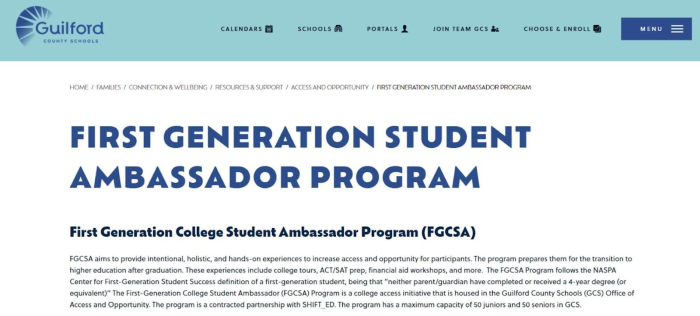
Source: Guilford County Schools
2. Establish Selection Criteria
Not every student is ambassador material. Create eligibility guidelines that reflect the qualities you need.
Look for:
- Strong communication and interpersonal skills
- Academic reliability (solid GPA)
- Active involvement in campus life
- A positive, professional online presence
Diversity matters, too. Aim for a team that represents different programs, backgrounds, and perspectives so prospective students can connect with someone who reflects their own journey.
Example: Vance-Granville Community College (NC): VGCC’s Student Ambassador Leadership Program sets strict selection criteria to ensure ambassadors have the right qualities. Applicants must “maintain a 3.0 GPA minimum” and be enrolled half-time, and they are evaluated on attributes like effective speaking skills, a positive first impression, adaptability, responsibility, and dependability. By codifying these requirements, VGCC attracts top student leaders who are academically solid and genuinely motivated to represent the college.
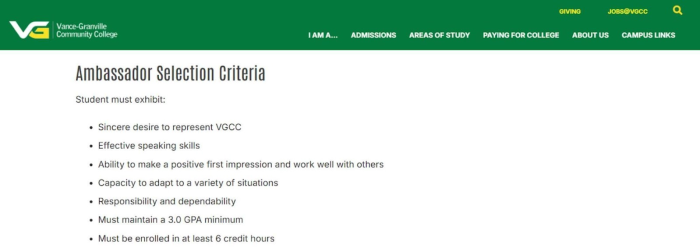
Source: Vance-Granville Community College
3. Application and Interview Process
Treat ambassador recruitment like a competitive job search.
- Ask for an application form where students share why they want the role.
- Request a short essay, or even better, a one-minute video to showcase personality and enthusiasm.
- Review their social media presence; as they’ll likely use it in the role.
- Conduct interviews or group activities to evaluate how they interact under pressure.
The mix of application, interview, and review helps you select students who are genuinely passionate and prepared to represent your school.
Example: Florida International University: FIU treats ambassador recruitment like a job hiring process, requiring candidates to go through multiple interview stages. Prospective FIU Student Ambassadors must “commit to participating in a phone interview, group interview, and a panel interview” as part of the application. Only students who successfully navigate all rounds and meet other requirements (e.g., 3.0 GPA, full-year commitment) are selected.

Source: Florida International University
4. Provide Training and Ongoing Support
Even the most outgoing students need preparation. Invest in structured training that covers:
- Public speaking and communication skills
- Diversity, equity, and inclusion awareness
- Social media and digital etiquette
- Detailed campus knowledge (history, traditions, key services)
Provide ambassadors with FAQ sheets on admissions, housing, or financial aid so they feel confident answering questions. Assign a staff coordinator as a mentor and check in regularly. Occasional refresher sessions help keep everyone sharp.
Example: Southside Virginia Community College: SVCC invests in training and team development for its ambassadors by mandating an orientation and an annual retreat. All new ambassadors must “attend annual Student Ambassador Orientation & Student Ambassador Retreat” and participate in monthly meetings. During these sessions, students receive guidance in public speaking, event hosting, and campus knowledge. The retreat, in particular, serves as both training and bonding – a dedicated time to build skills and camaraderie. Ongoing support from staff advisors (assigned at each campus) further ensures ambassadors have mentorship throughout the year.

Source: Southside Virginia Community College
5. Define Roles and Set Expectations
Clarity is essential. Outline exactly what ambassadors will do and how often.
Examples include:
- Weekly or monthly campus tours
- Required participation in a set number of events per semester
- Social media contributions (Instagram stories, blog posts, TikTok takeovers)
- Optional extras like mentoring first-year or international students
Compensation can be financial (work-study wages or stipends) or perks like free merch, event tickets, or professional development opportunities. Make sure the role feels rewarding and achievable alongside academics.
Example: Wichita East High School: East High’s ambassadors operate under a clear set of responsibilities and expectations. According to the program description, ambassadors lead campus tours for new students and visitors, assist peers with college and job applications (including FAFSA help), promote school events on social media, maintain information boards, and volunteer at key events like college fairs. They are required to contribute a minimum of 40 volunteer hours annually in these activities. Ambassadors must also uphold school conduct standards and serve as role models.
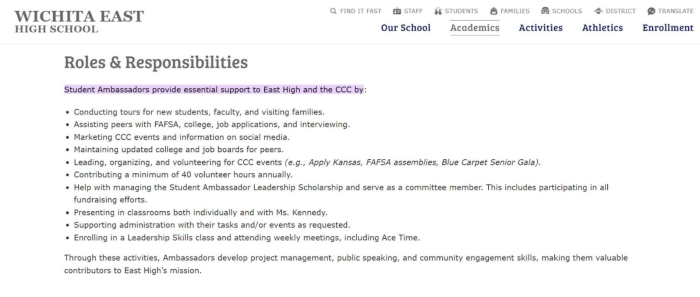
Source: Wichita East High School
6. Foster Team Spirit
A successful ambassador program is also a community. Encourage bonding through:
- Regular team meetings
- Social gatherings or retreats
- Recognition events or ambassador spotlights
A strong sense of camaraderie boosts morale and translates into better representation at events.
Example: The College Preparatory School: At College Prep, fostering community is central to the ambassador program. The school’s Admission Ambassadors represent a student body of 370, where connection, curiosity, and collaboration are defining values. Each ambassador profile highlights not only individual strengths but also the shared culture of independence, kindness, and deep relationships that tie the community together. By spotlighting ambassadors’ personal stories and the values they embody, College Prep nurtures a sense of team identity that extends beyond recruitment events. This approach creates cohesion among ambassadors themselves while reflecting the school’s wider commitment to inclusivity and connection, ensuring the program is both a showcase and a unifying force for the entire student body.
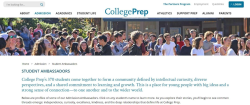
Source: The College Preparatory School
7. Integrate Ambassadors into Marketing
Think beyond tours and open houses. Ambassadors can be powerful storytellers for your brand.
- Invite them to contribute blogs, vlogs, or Q&As for your website.
- Run student social media takeovers for a “day in the life” view.
- Feature ambassadors in recruitment videos or email campaigns.
- Have them moderate online communities for admitted students, such as Facebook or Discord groups.
Encouraging ambassadors to share personal milestones, like landing an internship or study abroad experience, also strengthens your brand with authentic proof points.
Example: John Cabot University: JCU has woven student ambassadors directly into its admissions and marketing communications. The university’s website features a “Meet Your Student Ambassadors” page with profiles of current students (including photos, majors, hometowns, and personal stories) and actively invites prospects to connect with them. Interested students can schedule a one-on-one video call via Calendly or send an email to reach a JCU ambassador. This approach makes ambassadors a front-line part of marketing – essentially living testimonials that lend authenticity. JCU ambassadors also create content: they share their experiences through blogs and social media takeovers, giving an inside look at life in Rome.

Source: John Cabot University
8. Collect Feedback and Evolve
Don’t let your program run on autopilot. Measure its impact and adjust.
- Ask prospective students if ambassador interactions influenced their decision.
- Gather feedback from ambassadors about training, workload, and support.
- Monitor metrics: event attendance, social media engagement, and application trends.
If you notice gaps, like not enough STEM majors on your team or weak performance at virtual events, adapt accordingly. A good ambassador program evolves with your institution’s needs and with changes in student behavior.
Example: University of Guelph: Guelph’s social media ambassador initiative shows the importance of measuring impact and iterating. After launching the program, Guelph didn’t just celebrate a surge in likes and follows – they dug into analytics to see what prospective students cared about. For example, by tracking which web pages prospects visited via ambassadors’ posts, the admissions team discovered an unexpectedly high interest in student housing information. With that insight, they adjusted their content strategy: ambassadors began creating more posts about dorm life and residence tours.
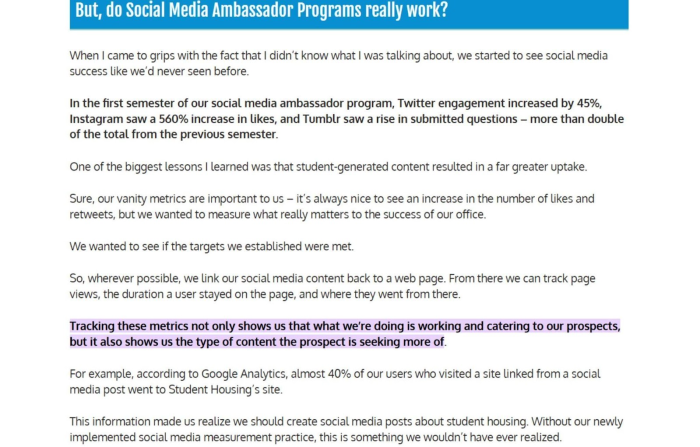
Source: Higher Ed Experts
Bringing It All Together
When structured thoughtfully, a student ambassador program becomes a win-win. Prospective students see a genuine, welcoming face of your institution. Current students gain leadership skills and professional growth. And your institution benefits from more authentic marketing, stronger recruitment outcomes, and an energized campus culture.
It’s more than a marketing tactic; it’s an investment in your community. Build it right, and your ambassadors will become some of your strongest advocates, now and well into their alumni years.
Turning Students Into Your Strongest Advocates
Student ambassador programs are far more than a recruitment tool. They are a way to put authentic student voices at the heart of your institution’s story. Ambassadors connect with prospects in ways no brochure or campaign ever could, offering real-life perspectives that build trust and spark genuine interest.
For institutions, the benefits are clear: more authentic marketing, stronger engagement, improved recruitment outcomes, and a livelier campus community. For students, it’s a chance to develop leadership, communication, and professional skills while giving back to the school they love.
The key is to be intentional. Define your goals, select the right ambassadors, support them with training, and continually refine the program. Done well, an ambassador initiative can become one of your institution’s most impactful long-term assets. Creating student advocates who not only help today’s prospects but remain champions of your brand long after graduation.
Frequently Asked Questions
Question: What is a student ambassador program?
Answer: A student ambassador program is a structured initiative where carefully selected students serve as official representatives of their school. These ambassadors, whether current students or recent alumni, act as the institution’s authentic storytellers, sharing first-hand experiences with prospective students, parents, alumni, and the wider community.
Question: What is the role of a student ambassador?
Answer: The short answer: a lot. They wear many hats, all focused on building connections and giving prospective students an authentic glimpse into campus life.
Question: What qualities does a student ambassador have?
Answer: A student ambassador has strong communication skills, enthusiasm, leadership, inclusivity, professionalism, knowledge of their institution, resourcefulness, and digital fluency, allowing them to authentically represent their school and connect meaningfully with prospective students.







